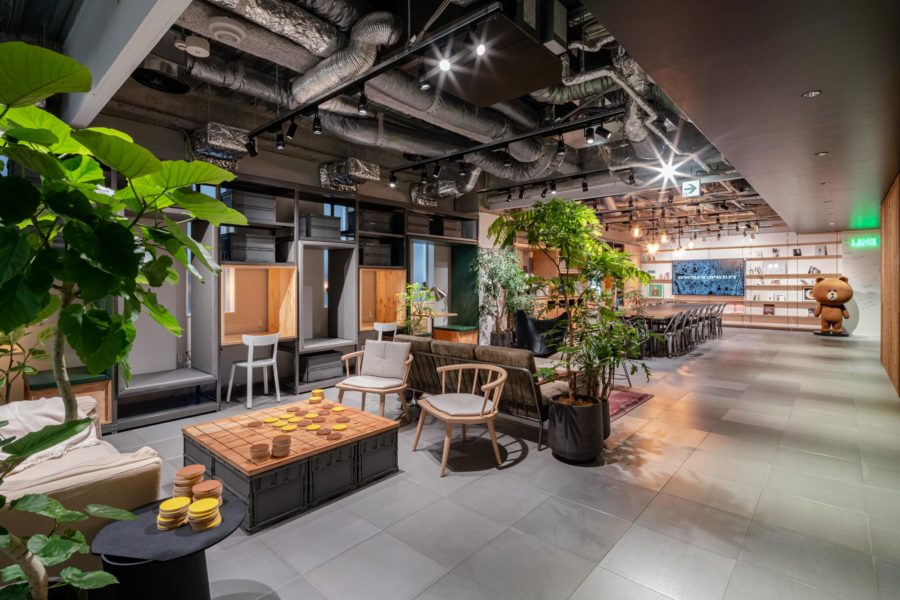京都府南部にある雛壇状の土地に建つ、高齢者の親世帯と息子世帯のための二世帯住宅である。建主は、両親を見守るため二世帯住宅を検討していた。近所付き合いの継続や引越しの負担など、今までの生活を大きく変えずに負担なく暮らせる土地を探していたところ、実家より徒歩3分の農地が売りに出ているのを発見し、購入を決めた。
計画地は高低差のある雛壇状の不整形地であり、かつては農地として利用されていたが長年放置され、荒れていた。理由としては、宅地にする場合に擁壁を建てなければ成らず、住宅が1つ建ってしまうくらいの莫大な費用をかける割には敷地が分断され、敷地全体を活用することが難しいためである。周囲の住宅も同様の問題に直面しており、通例に習い擁壁を設け、敷地の半分で住宅を建てて残りは駐車場や庭など、元から別敷地であったかのように住宅とほかを切り離して活用されており、土地のポテンシャルを活かしきれてないように思えた。この場所ならではの高低差のある豊かな敷地が、家を建てるために機械的に造成されて、小さくて平らなどこにでもあるものに書き換えられ、さまざまな事柄を分断している。
そこで本計画では、高低差のある敷地と住宅が一体となるような建ち方を模索した。具体的には、低い地盤に小さいボリュームを置き、高い地盤から長いボリュームを掛け渡すことで、いっさいの敷地造成をすることなく、必要な面積を確保しながら、住宅を敷地に着地させる。また、敷地と住宅の接地面を最小にし、基礎を減らしてコストダウンを図ると同時に、人や庭が入り込める隙間を設けることができる。こうすることで敷地全体が分断されることのない、起伏のあるひと繋がりの庭となり、立体的に住宅に巻き付くことで、外部⇄内部、敷地⇄地域、世帯⇄世帯等、大小さまざまなスケールの事柄を結び付けるきっかけとなると考えた。建てることで敷地と分断されるのではなく、建てることで敷地が生まれ変わり、住宅とよりよい関係になるような状況を目指した。
一方、建主の主な要求は「親世帯:生活がしやすいコンパクトな平屋、実家の荷物が収納できるロフト、育てている盆栽が置けるスペース」「子世帯:眺望がよいワンルーム、客人を招ける予備室、BBQができる庭」であり、共通して、行き来のない分離形式が求められた。以上をボリュームに当てはめて整理すると、高い地盤は、アクセス性を考慮し親世帯の平屋建て、低い地盤は、周囲に建物がなく眺望が取れることから2階建ての子世帯が望ましく、それらを長い屋根で繋ぐことで平屋建てと2階建てによる連層形式の長屋が構築された。
プランは、LDK⇄盆栽鑑賞、予備室⇄BBQなど住要求と庭が関連をもつように配置し、ボリュームによる日陰⇄日向や、敷地の高い⇄低いと相まって、ひと繋がりの中にも建主たちが暮らしながら多様な居場所を設えていけるように計画している。
構造は木造とし、ロフトを考慮した切妻屋根、流通材活用のため材長6m以下に抑える、カーポートと兼用した庇など、複雑な地形や条件に対し、シンプルな構成とすることで、コロナによる物価高騰の最中、コストも着地させることができた。
建主と引き渡し前の検査を行った時、「斜面にウッドデッキをつくりたい」と話をいただいた。引越しも済んでいないのに少し気が早いのではと驚いたが、できた長屋と庭に来てみることで、さらにイメージが膨らんだとのことだ。これは、長屋と庭の間に希望の暮らしを受け止めるおおらかな隙間があるからだと感じる。長屋によって荒れ果てた農地が庭に更新されたように、この庭が長屋と相互に関係をもつことで、暮らしを豊かに更新していくものになることを願う。(谷口弘和)
A house on a hinadachi lot where two families live in harmony with the shape of the land
This two-family house for elderly parents and their son is located on a terrace-shaped land in the southern part of Kyoto Prefecture. The owner was considering a two-family house to look after his parents. They were looking for a site where they could live without having to make major changes to their existing lifestyle, such as keeping up with their neighbors and the burden of moving when they found a piece of farmland for sale just a three-minute walk from their parent’s house.
The planned site is an irregularly shaped land in the shape of a terrace with an elevation difference. It used to be used as farmland, but it had been neglected for many years and had fallen into disrepair. The reason for this was that a retaining wall would have to be built if the land was to be converted into residential land, which would have cost an enormous amount of money, enough to build a single house, but would have divided the site and made it difficult to utilize the entire site. The surrounding houses also faced the same problem. As is customary, a retaining wall was built, a house was constructed on half of the site, and the rest was used as a parking lot or garden as if it had always been a separate site, and the potential of the land was not fully utilized. The rich site, with its unique differences in elevation, was mechanically developed to build a house, and rewritten as something small, flat, and ubiquitous, thus dividing the various aspects of the site.
Therefore, in this project, we sought a way to build the house so that the site with the elevation difference and the house become one. Precisely, by placing a small volume on low ground and a long volume on high ground, the house will land on the site while securing the necessary area without any site development. The ground clearance between the site and the house is minimized to reduce costs by reducing the number of foundations while at the same time allowing for gaps that allow people and gardens to enter. This would create an undulating, connected garden that does not divide the entire site, and by wrapping three-dimensionally around the house, it would provide an opportunity to connect matters of various scales, such as exterior and interior, site and community, household and household, and so on. We aimed to create a situation in which the site is reborn through the construction of the house, rather than being separated from the site by the construction of the house, and to create a better relationship with the house.
On the other hand, the main requirements of the client were: “Parents: a compact one-story house for easy living, a loft for storing the family’s belongings, and a space for growing bonsai trees,” and “Children: a one-room house with a great view, a spare room for inviting guests, and a garden for BBQ,” and the common request was for a separated form without traffic. The volumes mentioned above were arranged in the following way: on the higher ground, a one-story house for the parents was desirable for its accessibility; on the lower ground, a two-story house for the children was desirable because there were no buildings around, and they could enjoy the view; and by connecting them with a long roof, a row house was constructed with one and two stories in a row.
The plan is arranged in such a way that the living requirements and the garden, including the LDK, the bonsai viewing area, the spare room, and the BBQ, are related to each other, and the shade and the sunshine from the volume and the high and low points of the site are combined to allow the owners to create various living spaces within a single connection.
The structure is made of wood, with a gable roof to accommodate a loft, a timber length of 6m or less to use tradable timbers and an eave that doubles as a carport.
During the pre-delivery inspection with the client, he told us he wanted to build a wooden deck on the slope. We were surprised that this was a bit premature, as they had yet to move in, but after visiting the completed tenement house and garden, they had a further image of what they wanted to do. This is because there is a generous gap between the tenement and the garden that accepts the desired lifestyle. Just as the tenement house has renewed the farmland that had fallen into disrepair into a garden, this garden, through its mutual relationship with the tenement house, will enrich and renew the way of life in the area. (Hirokazu Taniguchi)
【八幡の二世帯住宅】
所在地:京都府八幡市
用途:戸建住宅
クライアント:個人
竣工:2023年
設計:谷口弘和設計室|HTA
担当:谷口弘和
構造設計:三崎洋輔(EQSD一級建築士事務所)
施工:株式会社ヴィーコ
撮影:笹倉洋平(笹の倉舎)
工事種別:新築
構造:木造
規模:地上2階
敷地面積:330.05m²
建築面積:155.02m²
延床面積:149.05m²
設計期間:2021.09-2022.05
施工期間:2022.05-2023.02
【Two-family house in Yawata】
Location: Yawata-shi, Kyoto, Japan
Principal use: Residential
Client: Individual
Completion: 2023
Architects: HTA
Design team: Hirokazu Taniguchi
Structure engineer: Yosuke Misakki / EQSD
Constructor: VICO
Photographs: Yohei Sasakura / Sasanokurasha
Construction type: New building
Main structure: Wood
Scale: 2 stories
Site area: 330.05m²
Building area: 155.02m²
Total floor area: 149.05m²
Design term: 2021.09-2022.05
Construction term: 2022.05-2023.02








